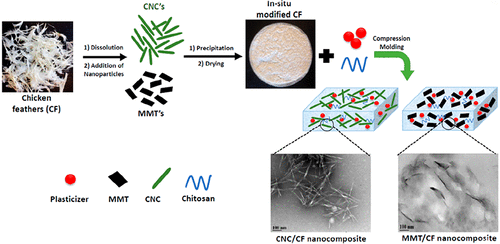Day 2 :
Keynote Forum
Mojtaba Moatamedi
UiT The Arctic University of Norway, Norway
Keynote: Multi-physics: Materials challenges in industrial applications
Time : 09:00-09:40

Biography:
M Moatamedi is currently the Chair of Multi-physics at UiT-The Arctic University of Norway where he is the Director of Multi-physics Centre. He has completed his MSc and PhD at The University of Sheffield, MBA at Manchester Business School and LLM International Business Law at The University of Leeds. He has an extensive experience in modeling and simulation particularly in multi-physics approach to industrial investigation. He has held Senior Managerial and Research positions in many institutes including Cranfield University, Imperial College London and the University of Manchester. He is a Fellow of the Royal Aeronautical Society and the Nuclear Institute and a Member of ASME. He is the Vice Chairman of the Association of Aerospace Universities and a Member of the Council and the Board of Directors of NAFEMS. He is the Founding President of The International Society of Multi-physics
Abstract:
Multi-physics simulation is a relatively new class of analysis in the field of engineering and science. Previously numerical modeling involved both fluid and structure which was undertaken using two separate codes, a Computational Fluid Dynamics (CFD) code for the fluid analysis and a Finite Element Analysis (FEA) code for the structural response. Recent advances in technology now enable the modeling of both fluid and structure within single code enabling a fully coupled analysis to be performed. This talk concentrates upon a number of applications concerned with the multi-physics modeling in real industrial problems involving new material challenges. These problems include a series of experimental data and simulations such as Concorde accident investigation, airbag certification, nuclear incident and other complex investigations. Experimental verification and validation of the numerical codes is essential in such practical applications to reduce the cost and enhance safety in design and manufacturing. The comparison between experiment and numerical analysis will be discussed in the above-mentioned applications.
Keynote Forum
Elias Siores
University of Bolton, United Kingdom
Keynote: Soft Fibre based Piezoelectric Energy Harvesting textiles
Time : 09:05-09:50

Biography:
Elias Siores is the Provost and Director of Research and Innovation, Bolton University. Educated in the UK (BSc, MSC, MBA, PhD) and pursued his academic career in Australia (Sydney, Brisbane and Melbourne) and Asia (Hong Kong, Dong Guan) before returning to Europe (UK) as a Marie Curie Fellow. His R&D work concentrated on advancing the science and technology in the field of automated Non-Destructive Testing and Evaluation including Ultrasound, Acoustic Emission, and Microwave Thermography. His recent R&D work focuses on Smart / Functional Materials and Systems development. In this area, he has developed Electromagnetic, Electrorheological, Photovoltaic and Piezoelectric Smart Materials based Energy Conversion Systems for Renewable Energy, Medical, Health Care and Wearable Devices. He has published over 300 publications including 8 Patents . He has been a member of editorial boards of international journals and a Fellow of IOM, TWI, IEAust, SAE and WTIA. He has served on Board of Directors of a number of research centres worldwide including UK, Australia, Singapore and Hong Kong, all associated with the Bio-Nano-Materials field. He has received 15 awards in his career for R&D achievements
Abstract:
For energy harvesting from human movement, fibre based electrical power generators are highly desirable as they are light weight and comfortable and look no different from the conventional fabrics. The conjunction of piezoelectric materials in fibres and therefore fabrics offers a simple route for the building of soft piezoelectric generators. The flexible textile structures can themselves be designed so as to provide piezoelectric output on low levels of strains and loadings while providing high fatigue resistance under a large number of variable mechanical deformation and loading cycles. In this work, we demonstrate “3D spacer” technology based all-fibre piezoelectric fabrics as power generators and energy harvesters (Figure 1(a)). The single step knitted structure consisting of high β-phase (~80%) piezoelectric PVDF produced using conventional melt spinning under high electric field (0.6 MV/m) are knitted together with Ag coated PA66 yarns acting as the top and bottom electrodes. The novel and unique textile structure provides an output power density in the range of 1.10-5.10 μWcm-2 at applied impact pressures in the range of 0.02-0.10 MPa, providing significantly higher power outputs and efficiencies over the existing 2D woven and nonwoven piezoelectric structures (Figure 1(b)). The all fibre piezoelectric fabric possesses the advantage of efficient charge collection due to intimate contact of electrodes and uniform distribution of pressure on the fabric surface, leading to enhanced performance. Furthermore, an substantial increase in piezoelectric output of the PVDF yarns has been achieved using ZnSnO3 based perovskite which has doubled the piezoelectric constant from 60 pm/V to nearly 130 pm/V. Bearing all these merits in mind, we believe our method of producing large quantities of high quality piezoelectric yarn and piezoelectric fabric provides an effective option for the development of high performance energy-harvesting textile structures for electronic devices that could be charged from ambient environment or by human movement. Furthermore, via the creation of hybrid photovoltaic films and fibres, energy can be captured from solar radiation and used where the mechanical impetus is absent. The high energy efficiency, mechanical durability and comfort of the soft, flexible and all-fibre based power generator is highly attractive for a variety of potential applications such as wearable electronic systems and energy harvesters charged from ambient environment or by human movement.
Keywords: Poly(vinylidene fluoride) PVDF, energy harvesting, piezoelectric effect, 3D spacer, textiles
Figure 1: Figure illustrating (a) change of α to β phase using UoB patented process, (b) structure of 3D spacer piezoelectric fabric, (c) measured power output of the 2D and 3D piezoelectric fabrics as a function of the impact pressure.
References:
- Soin, N., Shah, T. H., Anand, S. C., Geng, J., Siores, E. et al (2014) Novel 3D-spacer all fibre piezoelectric textiles for energy harvesting applications, Energy Environ. Sci, 7(5), 1670-1679
- Soin, N., Shah, T. H., Anand, S. C., Siores, E., (2013) 3D spacer piezoelectric fabrics and production of thereof, UK Patent application no. 1313911.8
- Siores, E., Hadimani, R. L., Vatansever (2012) Piezoelectric polymer element and production method and apparatus thereof, WO Patent WO/2012/035350
Keynote Forum
Manoj Gupta
National University of Singapore, Singapore
Keynote: Light weight magnesium based materials for CO2 mitigation and biomedical applications
Time : 09:40-10:20

Biography:
Manoj Gupta was the Former Head of Materials Division of the Mechanical Engineering Department and Director designate of Materials Science and Engineering Initiative at NUS, Singapore. He did his PhD from University of California, Irvine, USA (1992) and Postdoctoral Research at University of Alberta, Canada (1992). In August 2017 he was highlighted among Top 1% Scientist of the World Position by The Universal Scientific Education and Research Network. He has published over 455 peer reviewed journal papers and owns two US patents. He has also co-authored six books, published by John Wiley, Springer and MRF, USA
Abstract:
Image

Figure-1: Magnesium based syntactic composite processed using disintegrated melt deposition route.
Recent Publications
1. M Gupta and N Gupta (2017) Utilizing Magnesium based Materials to Reduce Green House Gas Emissions in Aerospace Sector. Aeronautics and Aerospace Open Access Journal; 1(1): 00005.
2. Vyasaraj Manakari, Gururaj Parande, Mrityunjay Doddamani, Manoj Gupta (2017) Enhancing the ignition, hardness and compressive response of magnesium by reinforcing it with hollow glass microballoons. Materials; 10: 997.
References
1. M Gupta and Sharon Nai (2011) Magnesium, Magnesium Alloys and Magnesium Composites. John Wiley.
2. M Gupta and N Gupta (2017) Utilizing Magnesium based Materials to Reduce Green House Gas Emissions in Aerospace Sector. Aeronautics and Aerospace Open Access Journal; 1(1): 00005
3. M Gupta and GK Meenashisundaram (2015) Insight into Designing Biocompatible Magnesium Alloys and Composites. SpringerBrief
4. S Jayalakshmi and M Gupta (2015) Metallic Amorphous Alloy Reinforcements in Light Metal Matrices. SpringerBrief.
5. Vyasaraj Manakari, Gururaj Parande, Mrityunjay Doddamani, Manoj Gupta (2017) Enhancing the ignition, hardness and compressive response of magnesium by reinforcing it with hollow glass microballoons. Materials; 10:997.
- Property Changing Smart Materials | Smart Materials & Structures | Materials in Industry | Emerging Materials | Nano Smart Materials | Future of Materials
Location: Dubai, UAE

Chair
Hamayun Khan
Islamia College University, Pakistan

Co-Chair
Janah Shaya
University de Strasbourg, France
Session Introduction
Ahmed S. Razeen
Cairo University, Egypt
Title: Effect of Ag-doping on the properties of ZnO thin films for UV stimulated emission
Time : 10:20-10:50

Biography:
Ahmed S. Razeen is a teaching assistant at the National Institute of Laser Enhanced Sciences (NILES), Cairo University. He finished his MSc. researches in thin film fabrication, focusing on the stimulated emission properties of ZnO thin films. He is interested in fabrication and characterization of new optical materials.
Abstract:
Ag doped ZnO thin films has been prepared using sol-gel spin coating method, with different doping concentrations. Structural and morphological properties of the films have been investigated by X-ray diffraction (XRD) and scanning electron microscopy (SEM) techniques. Thin films have been optically pumped and stimulated emission has been observed with strong peaks in the UV region. The UV stimulated emission is found to be due to exciton-exciton scattering, and Ag doping promoted this process by increasing the excitons concentrations in the ZnO lattice. Output-input intensity relation and peak emission, FWHM, and quantum efficiency relations with pump intensity have been reported. The threshold for which stimulated emission started has been evaluated to be about 18 MW/cm2 with quantum efficiency of about 58.7%. The role of Ag in enhancement of stimulated emission from ZnO thin films has been investigated.
Image:
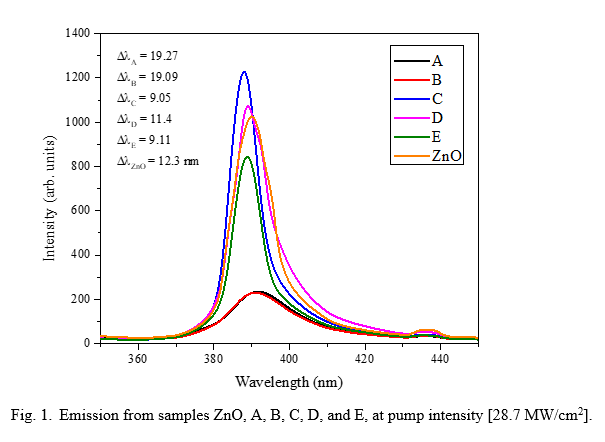
Recent Publications:
- Ahmed S. Razeen, A.-S. Gadallah, and M. M. El-Nahass, “Ultraviolet Stimulated Emission from Sol-Gel Spin Coated ZnO Thin Films,” Advances in Materials Science and Engineering, vol. 2017, Article ID 9464862, 7 pages, 2017. doi:10.1155/2017/9464862.
Zoran Eres
Rudjer Boskovic Institute, Croatia
Title: Simultaneous Synthesis of Single-layer and Multi-layer Graphene
Time : 11:05-11:35

Biography:
Zoran Eres has completed his MSc from Faculty of Electrical Engineering and Computing. He is working as an Expert Advisor at Rudjer Boskovic Institute, Zagreb, Croatia. He is currently a PhD student. He is the author of 1 patent, 9 conference papers and 10 official studies. He was Leader of project “High temperature cell for optical measurements in corrosive atmosphere” completed in 2015
Abstract:
Single-layer graphene (SLG) and multi-layer graphene (MLG) are synthesized in single batch using vacuum-assisted chemical vapor deposition (VA-CVD) process. Copper foil substrate is used as catalyst for SLG synthesis and nickel foil substrate is used as catalyst for MLG synthesis. Substrates are placed in VA-CVD reactor tube, copper substrate positioned as first and nickel as second relative to gas inlet port. Substrates are annealed in hydrogen atmosphere at 1273 K for 60 minutes. Methane gas is used as carbon atom source with growth time of 30 minutes. Cooling rate is critical variable in MLG synthesis-flash cooling resulted in no MLG deposits while cooling rates of 5 K/minute resulted in good MLG deposits. Raman spectrums of SLG samples indicate low concentration of defects and thickness of one graphene layer. Raman spectrum of MLG indicate medium to high concentration of defects and multiple graphene layers. This method can substantially reduce amount of man-hours if one needs to synthesize both SLG and MLG.
Image:
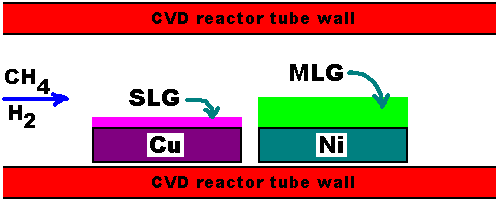
Recent Publications:
- Z. Eres, S. Hrabar, Low-cost multi-layer graphene for linear/non-linear metasurface applications, 2016 10th International Congress on Advanced Electromagnetic Materials in Microwaves and Optics, METAMATERIALS 2016,7746463, pp. 136-137
- Z. Eres, S. Hrabar, Graphene for metamaterials: Synthesis using do-it-yourself low-cost reactor, 2015 9th International Congress on Advanced Electromagnetic Materials in Microwaves and Optics, METAMATERIALS 2015,7342473, pp. 421-423
Hamayun Khan
Islamia College University, Pakistan
Title: Polypyrrol/MnO2 composites: Synthesis, characterization and analytical applications
Time : 11:35-12:05

Biography:
Hamayun Khan has completed his PhD in Chemistry/Chemical Engineering from Kyungpook National University, Republic of Korea. Currently, he is working as an Associate Professor, Department of Chemistry, Islamia College University, Pakistan and taught Analytical Chemistry as major subject. His fields of interests are environmental and bio analytical chemistry, material chemistry, separation science and technology, wastewater treatment, resource recycling and waste management. He has published one Korea patent, one chapter in book and more than 50 papers in reputed journals. He has served as the Director Academics and ORIC of Islamia College University, Peshawar, Pakistan.
Abstract:
Synthesis, characterization and analytical applications of polypyrrole (PPy)-MnO2 composites is presented herein. PPy and its composites were synthesized in the aqueous medium by a modified chemical oxidation polymerization method using ferric chloride as an oxidant. The materials were characterized by FT-IR, XRD, TGA, UV-visible, SEM and EDX spectroscopic and analytical techniques. The FT-IR results confirmed the successful synthesis of PPy and PPy/MnO2 composites with amorphous and crystalline structures, respectively and enhanced thermal stability in case of composites. The SEM and EDX data showed the porous nature of the materials with desired elemental composition. The BET surface area was also determined and found to be increases with the increase of MnO2 content in the composites. The UV-visible spectral analysis confirmed the doping of PPy in composites and found the decrease in the energy band gap values with the increase of MnO2 content in the composites. The analytical applications such as electrical and gas sensing of the synthesized materials were also determined using LCR-meter. The results showed the semiconducting behavior of the materials where the resistance is dependent on temperature and MnO2 content of the composites. The gas sensing behavior of the materials showed high selectivity and sensitivity towards NH3 using 1 to 30 ppm concentration with 0.4 ppm LOD at 25 oC. The sensitivity, response and recovery times of the materials were also determined.
Image
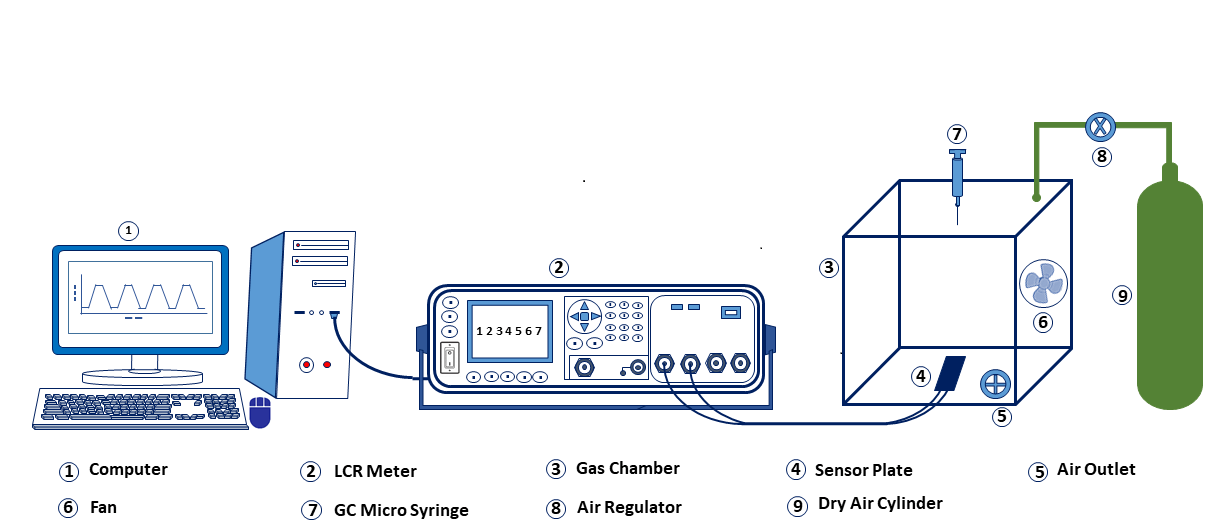
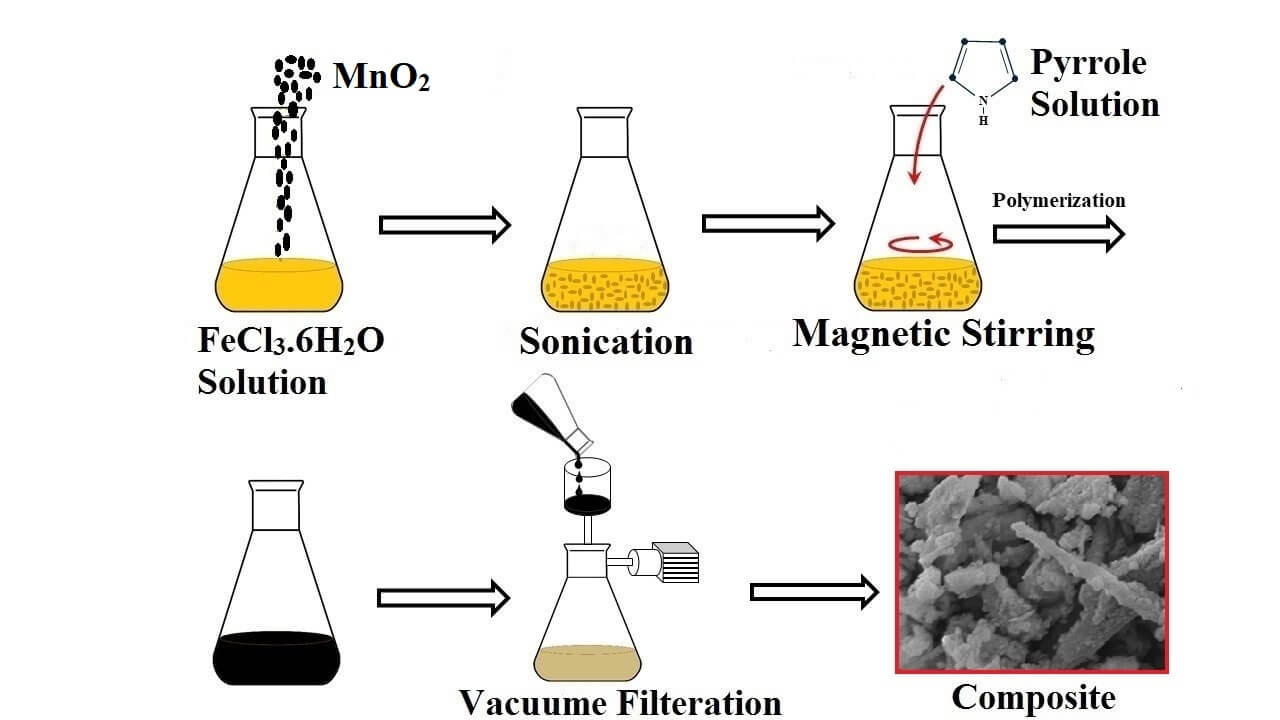
Figure-1: Schematic presentation of the synthesis, characterization and analytical applications of PPy/MnO2 composites
Recent Publications
1. Ali N, Ismail M, Khan A, Khan H, Haider S, Kamal T (2018) Spectrophotometric determination of urea in real samples using silver nanoparticles by standard addition and 2nd order derivative methods. Spectrochimica Acta Part A: Molecular and Biomolecular Spectroscopy; 189: 110-115.
2. Malook K, Khan H, Shah M, Ihsan-Ul-Haque (2018) Synthesis, characterization and electrical properties of polypyrrole/V2O5 composites. Korean Journal Chemical Engineering 35(1): 12-19.
References
1. Zhang A Q, Xiao Y H, Lu L Z, Wang L Z, Li F (2013) Polypyrrole/MnO2 composites and their enhanced electrochemical capacitance. J. Appl. Polym. Sci.; 130: 1327-1331.
2. Ramesan M T (2013) Synthesis, characterization, and conductivity studies of polypyrrole/copper sulfide nanocomposites, J. Appl. Polym. Sci.; 128: 1540-1546.
3. Yang X, Li L, Zhao Y (2010) Ag/AgCl-decorated polypyrrole nanotubes and their sensory properties. Synth. Met.; 160: 1822-1825
Hiroshi Asanuma
Chiba University, Japan
Title: Novel Applications of Smart Materials and Structures Aiming at Disaster Mitigation
Time : 12:05-13:05

Biography:
Hiroshi Asanuma has been developing the field of smart materials/structures and related technologies for many years by proposing new concepts and demonstrating them, which include such as metal-based smart composites (fiber reinforced metals capable of fiber-matrix sliding for secondary forming, healing, etc., optical fiber embedded aluminum etc. as structural materials having robust sensing function, metal-core piezoelectric fiber embedded aluminum etc. as structural materials having robust sensing/actuating/energy harvesting functions, active laminates having variety of functions such as actuating/sensing/repairing, and so on. After the serious earthquake and tsunami disasters in Japan in 2011, he started to apply smart materials/structures including his variety of robust materials, and has proposed the novel concept of “Disaster Mitigation and Sustainable Engineering” with his colleagues, which intends to enable sustainability as well as disaster mitigation, effectively and economically. He has developed a research committee, organized workshops/conference sessions, delivered plenary/keynote/invited presentations and seminars to establish the new world.
Abstract:
The author et al. have proposed to use novel materials/technologies such as smart materials/structures and related technologies to enable revolutionary prevention/mitigation of disasters. The deployable breakwater shown in Figure 1 is an example, which can be used daily for energy harvesting, small enough not to become an obstacle, and a smart breakwater deployable by force and material of tsunami etc.1) The author et al. discussed new approaches which enable sustainability as well as disaster mitigation, and named it “Disaster Mitigation and Sustainable Engineering.” Then the author developed a committee in JSME M&P division. In this presentation, smart disaster mitigation strategies especially based on smart materials/structures are described. To realize the concept, two elemental researches, i.e. artificial forest and novel deployable structure based on honeycomb are examined.1) The researches below are also undergoing by the author and/or his collaborators. (i) Applications of piezoelectric polymers in electrical power generation using ocean waves (Su). (ii) Dynamic deployment of smart inflatable tsunami airbags (Shahinpoor).2) (iii) A novel underwater inflatable structures for smart costal disaster mitigation (Adachi). (iv) SHM of pipelines for environment pollution mitigation (Felli et al.).3) (v) The contribution of LARES to global climate change studies (Sindoni et al.).4) (vi) Smart disaster mitigation in Italy (Felli et al).5) (vii) Smart disaster mitigation in Thailand (Aimmanee et al.).6) In addition, Kubo, Tanaka, Maruyama and Asanuma started to develop a multi-layered deployable structural material system to dissipate wave energy by separating water flow and letting them collide. Challenges have been also done in industries and some are commercialized. Especially, neo RiSe flap-gate type seawall (Hitachi Zosen), SHELCAR (STARLITE Co., Ltd.), MOSE Project and Aqua Dam are attractive. Takenaka Corporation proposed innovative “Breakwater and breakwater group.” Toward future, Disaster Mitigation and Sustainable Engineering has to be brushed up to smartly overcome or rather utilize disasters.
Figure 1:
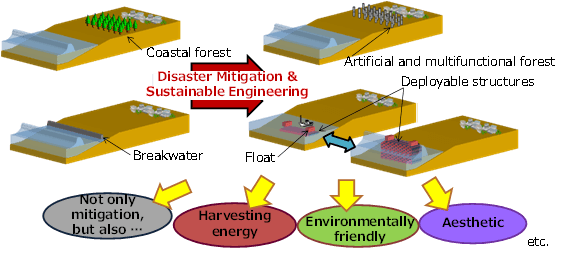
Typical examples to show the concept of “Disaster Mitigation and Sustainable Engineering.”
Recent Publications
- Asanuma H, et al. (2016) Disaster mitigation based on smart structures/materials. SPIE Vol. 9803, Paper No. 980302-1: 1-12.
- Shahinpoor M, Asanuma H (2015) Dynamic deployment of smart inflatable tsunami airbags (TABS) for tsunami disaster mitigation. Proc. ASME SMASIS2015, Paper No. 2015-8904: 1-4.
- Felli F, et al. (2015) Structural health monitoring of pipelines for environment pollution mitigation. Proc. ASME SMASIS2015, Paper No. 2015-8922: 1-7.
- Sindoni G, et al. (2015) The contribution of LARES to global climate change studies with geodetic satellites. Proc. ASME SMASIS2015, Paper No. 2015-8924: 1-7.
5. Felli F, et al. (2014) Smart disaster mitigation in Italy, Proc. ASME SMASIS2014, Paper No. 2014-7631, 1-8.
- Bioactive Smart Materials | Shape Changing Smart Materials
Location: Dubai, UAE

Chair
Hamayun Khan
Islamia College University, Pakistan

Co-Chair
Janah Shaya
University de Strasbourg, France
Session Introduction
Aman Ullah
University of Alberta, Canada
Title: Amphiphilic polymeric nanoparticles for drug delivery
Time : 16:35-16:50

Biography:
Aman Ullah has received his PhD in Chemical Sciences and Technologies in 2010 at the University of Genova, Italy by working together at Southern Methodist University, USA. He worked as a postdoctoral fellow before accepting an Assistant Professor position at the University of Alberta. He has been promoted to Associate Professor with Tenure. He has been teaching a graduate course entitled “Renewable Biomaterials”. He has published more than 40 papers in reputed journals and three patents/patent applications. His research is focused on the development of biochemicals, biopolymers/biomaterials from lipids and other renewable resources.
Abstract:
Amphiphilic block copolymers and ABA type PEG-Lipid conjugated macromolecules have been synthesized using microwave-assisted reversible addition-fragmentation chain transfer (RAFT) polymerization and the copper-catalyzed azide-alkyne cycloaddition commonly termed as “click chemistry”, respectively. Characterization of the block copolymers and conjugates has been carried out with the help of 1H-NMR, FTIR and GPC. These copolymers and conjugates were evaluated for the encapsulation and release of drug. Carbamazepine, an anticonvulsant drug with poor water solubility was selected to be a hydrophobic drug model in the study. The micellization, drug encapsulation and release behavior of macromolecules was investigated by dynamic light scattering (DLS), transmission electron microscope (TEM) and fluorescence spectroscopy. From the results, it has been concluded that the nanoparticles had different average sizes due to different ratio of hydrophilic contents in the block or conjugate backbone. The particle size and structure could be altered by changing the ratio of hydrophilic and hydrophobic contents. The in vitro drug encapsulations highlighted that all the drug-loaded micelles had spherical or near-spherical morphology. In vitro drug release study showed the controlled release of hydrophobic drug over a period of max. 70 hours. The results indicate that there is great potential of renewable lipid-based micelle nanoparticles to be used as hydrophobic drug carriers.
Recent Publications
- Arshad M, Pradhan RA, Ullah A (2017) Synthesis of lipid-based amphiphilic block copolymer and its evaluation as nano drug carrier. Mater. Sci. Eng. C.; 76: 217-223.
- Zhang S, Arshad M, Ullah ​​A (2015) Drug encapsulation and release behavior of telechelic nanoparticles. Nanotechnology; 26: 415703.
References
- Fang et al. (2013) Nanostructured lipid carriers (NLCs) for drug delivery and targeting. Recent Pat Nanotechnol; 7(1): 41-55.
- Nishiyama et al. (2006) Current state, achievements, and future prospects of polymeric micelles as nanocarriers for drug and gene delivery. Pharmacol Ther.; 112(3): 630-48.
Arun M. Umarji
Indian Institute of Science, India
Title: Aluminium quenched Brownmillerite type SrCoO2.5 for oxygen enrichment
Time : 15:35-16:05

Biography:
Following his Ph. D. from IIT, Madras in 1980, Prof. A. M. Umarji held post-doctoral positions at IIT Madras, Argonne National Laboratory, USA and at TIFR in Mumbai. He has been a faculty member of the Materials Research Centre since 1987. He was a visiting faculty member (1997-98) at the Ceramics and Materials Eng. Department, Rutgers University, Piscataway, NJ- USA.
Abstract:
Ternary oxides are known for many applications like solid oxide fuel cells, catalysis, gas sensing etc [1]. These oxides can be oxygen non-stoichiometric if transition metals with variable oxidation states are present. This can be regarded as a functionality if the extent of oxygen vacancies inside the lattice is very high. They can transport oxygen through the lattice when a partial pressure gradient of oxygen is applied. This is normally exploited in case of Oxygen separation membranes [1]. Perovskite oxides (general formula ABO3) are promising candidates as they can exist in a variety of oxygen non-stoichiometric forms with varying temperature and oxygen partial pressure. SrCoO3 (Perovskite, Pm m) is one of such material which reversibly transforms to SrCoO2.5 (Brownmillerite, Ima2) phase at 350°C [2]. Here in we report the application of Brownmillerite SrCoO2.5 for oxygen enrichment.
Brownmillerite (BM) SrCoOx phase has been stabilized to date only by liquid nitrogen quenching [3]. We report a novel and cost-effective method of quenching for the synthesis of the BM SrCoOx. T. Dasgupta et al. [4]reported a quenching method using Al foil pads to control oxygen stoichiometry of REBaCo2O5+d. Herein, we extend this method to stabilize the BM phase of SrCoO2.5. The solution combustion synthesized powder was calcined and sintered at 1223 K in pellet form. This pellet was quenched to 473 K using Al foil pads to stabilize the intact ceramic with Brownmillerite phase. A simple home-built volumetric setup has been fabricated for studying the Oxygen storage property of the material [5]. The sample was pre-treated with a higher partial pressure of oxygen at 673 K to form the oxygen-rich perovskite phase and this phase was heated at lower pressure to study the desorption characteristics. The pressure change observed when sample releases oxygen is used to find the oxygen storage capacity. Desorption characteristics of the sample treated at varying oxygen partial pressure have been studied. The results indicate 14.72 litres/kg of oxygen can be stored in the sample at STP.
Image

Recent Publications
[1] J. Sunarso, S.S. Hashim, N. Zhu, W. Zhou, Perovskite oxides applications in high temperature oxygen separation, solid oxide fuel cell and membrane reactor: A review, Prog. Energy Combust. Sci. 61 (2017) 57–77. doi:10.1016/j.pecs.2017.03.003.
[2] H. Jeen, W.S. Choi, M.D. Biegalski, C.M. Folkman, I.-C. Tung, D.D. Fong, J.W. Freeland, D. Shin, H. Ohta, M.F. Chisholm, H.N. Lee, Reversible redox reactions in an epitaxially stabilized SrCoOx oxygen sponge., Nat. Mater. 12 (2013) 1057–63. doi:10.1038/nmat3736.
References:
[1] Y. Takeda, R. Kanno, T. Takada, O. Yamamoto, M. Takano, Y. Bando, Phase Relation and Oxygen-non-stoichiometry of Perovskite- like Compound SrCoOx (2.29 < x < 2.80), Z. Anorg. Allg. Chem. 541 (1986) 259–270.
[2] T. Dasgupta, S. Sumithra, Arun M. Umarji, A novel method to control oxygen stoichiometry and thermoelectric properties in (RE)BaCo2O5+δ, Bull. Mater. Sci. 31 (2008) 859–862.
[3] Aswathy M. Narayanan, Rajasekar P., Arun M. Umarji, Stabilization of Brownmillerite type SrCoO2.5 by a Costeffective Quenching method for Oxygen Scavenging Applications, Submitt. to Ind. Eng. Chem. Res. (2018).
Santanu Mandal
Carborundum Universal Limited, India
Title: Smart Materials – A Quantum Jump in Technological Advancement
Time : 14:05-15:05

Biography:
Dr. Santanu Mandal joined Carborundum Universal Limited (CUMI) right after accomplishment of Ph.D. Thesis Programme at CSIR – CG&CRI in 2001. In 1994, he did his graduation in Chemical Technology with specialization in Ceramic Engineering & M.Tech. in Ceramic Engineering from University of Calcutta in 1996. In CUMI, Dr. Santanu has been working in R&D and Technology function at various capacity & right now is leading a fine young Team of Research & Development (DSIR approved IRD Unit) of Carborundum Universal Limited, Ceramic division which is dealing with wear resistance & technical ceramic products for industrial & advanced applications. Recently, as an additional responsibility he is leading the Technology and R&D of Wendt (India) Limited which is dealing with CBN & Diamond-based Super Abrasive Products.
The key responsibilities are (a) New Business Development through “Ideation to Launching” of New Products in line with CUMI’s strategic intent through In-house R&D or Technology Cooperation/absorption, (b) New Technology, Product & Process Development (c) R&D Process & Product Portfolio Management.
Innovation Awards:
- Chairman Innovation Award (in CUFEST - 2010) for the Development of Zero-expansion Reaction-Sintered Aluminium Titanate Ceramics
- Chairman Innovation Award (in CUFEST 2014) for the Development of high-strength sub-micron grade Alumina Ceramics for Thin-film Metallized Substrate & other Advanced Applications
- Chairman Innovation Award (in CUFEST 2015) for the Development of Thermal Grade of Zirconia Products for Ferrous Handling & other Thermal Applications
Publications/Patents:
- Published 33 Papers in International/National Journal and Proceedings
- Granted/Filed 18 Patents in India
Abstract:
Whether the extension of Le Chatelier’s principle applies to human being and materials? It does apply to human being and hence it ranks right at the top in the hierarchy of smartness/intelligence. The human being can process data, convert into information, develop knowledge, gains wisdom and applies it.
Can it be engineered to develop smart/intelligent materials so that it respond to external stimulus and changes its response with the help of change in bonding, crystal structure and microstructure? There are certain materials which are inherent smart/intelligent, whereas there are materials need to be induced to generate smartness/intelligence. The former group of materials can be coined as ‘Inherent Smart’ materials whereas the latter can be called as ‘induced smart’ materials. For example, structural smartness behaviour under stress can be induced on monoclinic zirconia through partial stabilization with appropriate amount of Y2O3 dopant whereas functional smartness can be induced to conduct oxygen ions with the same Y2O3 dopant at different proportion. Again, the increase in strength with increasing temperature for certain class of materials like dense Al2TiO5, SiC ceramics can be the example of inherent smart ceramics. In sintered Al2TiO5 such behaviour arises due to the presence of micro-fissures. The micro-fissures forms due to thermal hysteresis loop during heating & cooling because of thermal expansion anisotropy in its pseudobrookite crystal structure. Likewise, self-healing materials/composites, self-cleaning glass are the examples of inherent smart materials. In case of functional materials, usually sensors are induced smart materials whereas transducers are inherent smart materials. The presentation will be dealt with many examples of smart materials along with scientific explanation & related applications. This new class of smart materials is believed to contribute quantum jump in human comfort & happiness as well as in economic progress.
Image:

Recent Publications:
- Takagi, T. et al, (1990). “A concept of intelligent materials”. J. Intell. Mater. Syst. Struct., 1: 149-156.
- Kessler et al., (2003). "Self-healing structural composite materials". Composites Part A: Applied Science and Manufacturing. 34 (8): 743–753.
- S.E. Prasad et al., (1995). "Ceramic Sensors and Actuators for Smart Structures". Robotics and Knowledge Based Systems Workshop, Canadian Space Agency.
- Rewadee Wongmaneerung et al., (2009). “Potential of Nanocomposite Technique for Fabrication of Smart Ceramics”. Chiang Mai J. Sci. 36(2) : 179-187
- “Smart Materials and Structures: New Research” Book by Peter L. Reece (2006)
Vladimir U Nazarov
Academia Sinica, Taiwan
Title: Electron energy-loss spectroscopy of quasi-2D crystals: Beyond the energy-loss functions formalism
Time : 16:20-16:35

Biography:
Vladimir U Nazarov is currently the Associate Research Fellow at the Research Center for Applied Sciences, Academia Sinica, Taiwan. He has received his BSc and MSc in Physics from the Far-Eastern National University, Vladivostok, Russia and his PhD degree from the Institute for Automation and Control Processes, Far-Eastern Branch of Russian Academy of Sciences, Vladivostok, Russia.
Abstract:
Inelastic scattering of the medium-energy (~10-100 eV) electrons underlies the method of the high-resolution electron energy-loss spectroscopy (HREELS), which has been successfully used for decades to characterize pure and adsorbate-covered surfaces of solids. With the emergence of graphene and other quasi-two-dimensional (Q2D) crystals, HREELS could be expected to become a major experimental tool to study this class of materials. We, however, identify a critical flaw in the theoretical picture of the HREELS of Q2D crystals in the context of the inelastic scattering only (“energy-loss functions” formalism), in contrast to its justifiable use for bulk solids and surfaces. The shortcoming is the neglect of the elastic scattering, which we show is inseparable from the inelastic one and which, affecting the spectra dramatically, must be taken into account for the meaningful interpretation of the experiment. With this motivation, we build a theory of the simultaneous inelastic and elastic electron scattering at Q2D crystals. We apply this theory to HREELS of graphene, revealing an important effect of the strongly coupled excitation of the π+σ plasmon and elastic scattering resonances. Our results open a path to the consistent and interpretable study of the elementary excitations in crystalline mesoscopic materials by means of HREELS, with its supreme resolution on the meV energy-scale, which is far beyond the capacity of the now overwhelmingly, used EELS in transmission electron microscope.
Recent publications
- V U Nazarov (2017) Quasi-low-dimensional electron gas with one populated band as a testing ground for time-dependent density-functional theory of mesoscopic systems. Physical Review Letters; 118: 236802.
- V U Nazarov (2016) Exact exchange potential of two- and one-dimensional electron gases beyond the asymptotic limit. Physical Review B; 93: 195432.
References
- V. U. Nazarov, E. E. Krasovskii, and V. M. Silkin (2013),Scattering resonances in two-dimensional crystals with application to graphene. Phys. Rev. B 87:041405(R).
- V. U. Nazarov, V. M. Silkin, E. E. Krasovskii (2017) Probing mesoscopic crystals with electrons: One-step simultaneous inelastic and elastic scattering theory, Phys. Rev. B 96: 235414.
Nazrin Abdullayeva
TOBB University of Economics and Technology, Turkey
Title: Copper-Indium-Sulfide Based Flexible Electrodes for Solar Water Splitting
Time : 15:05-15:35

Biography:
Nazrin Abdullayeva is currently a PhD. student in the Materials Science and Nanotechnology Engineering Department at the TOBB University of Economics and Technology (TOBB ETU), Ankara, Turkey. She has graduated from the Department of Chemical Engineering of Hacettepe University, Ankara, Turkey in 2015. She has received her Master degree in Materials Science and Nanotechnology Engineering from TOBB University of Economics and Technology (TOBB ETU), Ankara, Turkey in 2017. Nazrin has carried out researches in the field of conductive polymers and ionomers, photovoltaic devices, semiconductor materials and thin film solar cell applications.
Abstract:
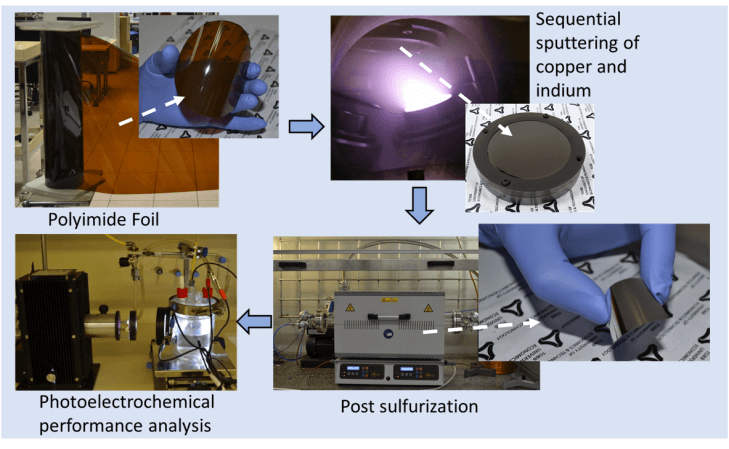
Janah Shaya
Université de Strasbourg, France
Title: Economic syntheses of push-pull fluorene probes using air-stable Pd catalytic systems: Applications into imaging of lipid membranes

Biography:
Janah Shaya is a Postdoctoral Fellow and Instructor with the CNRS at the IPCMS of Strasbourg in collaboration with Kyushu University, Japan. He has received his PhD degree from University of Nice Sophia Antipolis in France in September 2016. He is currently the Co-Editor of two books on carbon dioxide and cross couplings with Intech Open publisher.
Abstract:
Extensive research continues to find catalytic methods and straightforward syntheses for biological and environmental applications. In particular, the architecture of new fluorescent tools is of huge demand. Push-pull dyes exhibiting the two-photon absorption (2PA) property are of particular interest. These dyes are highly responsive to changes of environment. They constitute useful biosensors and probes for specific detections of nucleic acids. They also enable imaging and penetration into cells with reduced photo-damage. Our work presents: 1) Step-economic and concise approaches to a spectrum of push-pull fluorene dyes: As an example, a planned route involved one-pot synthesis installing both the electron-donor and acceptor. Another route comprised selective formylation followed by C-N cross coupling via air-stable palladium catalytic systems, 2) Photo-physical characterization and structure-property relationships of a library of 20 synthesized fluorene compounds and 3) Application of an optimized solvatochromic fluorene probe to imaging lipid organization in cell membranes. The presented fluorene dye outperforms the features of popular probes like Laurdan. Some of the established improvements are: red-shifted absorption that matches the 405 nm diode laser, higher brightness decreasing the used concentration for such staining by 20 folds, remarkable photo-stability, compatibility with two-photon excitation at wavelength more than 800 nm, among others.
Figure-1: Graphical abstract.
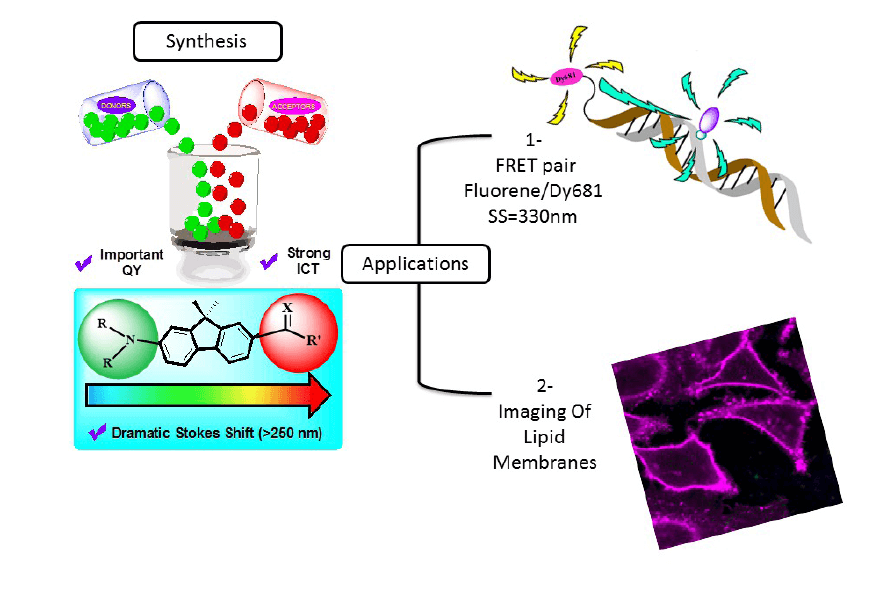
Recent Publications
1. P M Holstein, D Dailler, J Vantourout, J Shaya, A Millet, O Baudoin (2016) Synthesis of Strained γ-Lactams by Palladium(0)-Catalyzed C(sp3)–H Alkenylation and Application to Alkaloid Synthesis. Angew. Chem. Int. Ed.; 55: 1–6.
2. J Shaya, F Fontaine-Vive, B Y Michel, A Burger (2016) Rational design of push-pull fluorene dyes: synthesis and structure-photophysics relationship. Chem. Eur. J.; 22: 10627-10637.
References:
1. J. Shaya, F. Fontaine-Vive, B. Y. Michel, A. Burger, “Rational design of push-pull fluorene dyes: synthesis and structure-photophysics relationship”, Chem. Eur. J. 2016, 22, 10627-10637.
2. J. Shaya, M. A. Deschamps, B. Y. Michel, A. Burger, “Air-stable palladium catalytic systems for sequential one-pot synthesis of challenging unsymmetrical aminated products”, J. Org. Chem. 2016, 81, 7566-7573.
3. J. Shaya, M. Collot, F. Bénailly, N. Mahmoud, Y. Mély, B. Y. Michel, A. S. Klymchenko, A. Burger, “Turn-On Fluorene Push-Pull Probes with High Brightness and Photostability for Visualizing the Different Liquid Domains of Cell Membranes”, ACS Chemical Biology, 2016, 12, 3022-3030.
4. S. Huang, C. Chen, H. Tsai, J. Shaya, C. Lu, “Photocatalytic degradation of thiobencarb by a visible light-driven MoS2 photocatalyst”, Separation and Purification Technology, 2018, 197, 147-155
- Poster Presentations
Location: Dubai, UAE

Chair
Santanu Mandal
Carborundum Universal Limited, India
Session Introduction
Arun M Umarji
Indian Institute of Science, India
Title: Fabrication of device quality VO2 thin films

Biography:
Arun M Umarji had pursued his PhD from IIT and held Postdoctoral positions at Argonne National Laboratory, USA and at TIFR in Mumbai. He has been a Faculty Member of the Materials Research Centre since 1987. He was a Visiting Faculty Member at the Ceramics and Materials Engineering Department, Rutgers University, USA.
Abstract:
Semiconductor to metal transition (SMT) in metal oxide is the most fascinating field of research in materials science. This transition can be triggered by thermal, electrical, strain, etc. where oxides show a drastic change in resistivity. Large number of oxides are known to show this kind of transition but VO2 shows this transition near to room temperature (TSMT ~68 ºC). It undergoes a change in crystal structure from monoclinic phase (M1, P21/c) to tetragonal phase (R, P42/mnm). Due to this phase transition it has been used for various applications like smart windows, metamaterial, bolometers, etc. Herein, we report the synthesis of device quality VO2 thin films. Various methods like home-built Ultrasonic Nebulized Spray Pyrolysis of Aqueous Combustion Mixture (UNSPACM), Chemical Vapor Deposition (CVD), Pulsed Laser Deposition (PLD) and DC Reactive sputtering have been employed to synthesize the thin films. The structural characterization of the thins films have been carried out by XRD and Raman measurements which confirms the M1 phase of VO2 at room temperature followed by high temperature measurements to study the phase change to R phase. A temperature dependent resistance measurement confirms the SMT transition at 68 ºC with a three-four order of magnitude change in resistance. Temperature dependent IR measurements show ~80% change in reflectance across the phase transition where the thin film acts as an IR reflector (T>TSMT). Effect of substrate, synthesis process, post-annealing on SMT have been studied.
Image
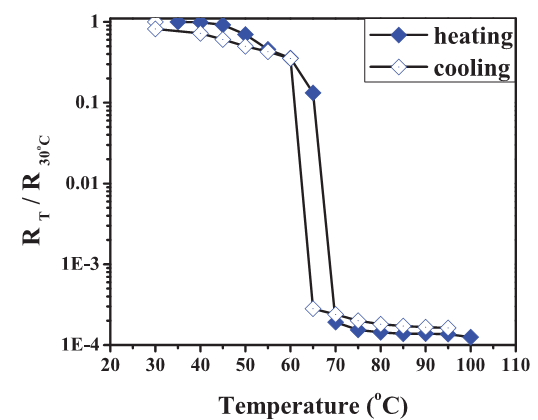

Figure-1: Left figure shows the change in resistance and right shows the change in reflectance as a function of temperature for VO2 thin films synthesized using UNSPACM.
Recent Publications
- R Bharathi, A M Umarji, et al. (2017) Thermochromic VO2 thin films on ITO-coated glass substrates for broadband high absorption at infra-red frequencies. Journal of Applied Physics; 122(16): 163107.
- Pradhan J K, A M Umarji, et al. (2017) High contrast switchability of VO2 based metamaterial absorbers with ITO ground plane. Optics Express; 25(8): 9116-9121.
References
- Yang Z, C Ko and S Ramanathan (2011) Oxide Electronics Utilizing Ultrafast Metal Insulator Transitions. Annual Review of Materials Research; 41(1): 337-367.
- Good enough J B (1971) The two components of the crystallographic transition in VO2. Journal of Solid State Chemistry; 3(4): 490-500.
Manoj Gupta
National University of Singapore, Singapore
Title: Evolution of lightweight high entropy alloys for weight critical applications

Biography:
Manoj Gupta is a former Head of Materials Division of the Mechanical Engineering Department and Director designate of Materials Science and Engineering Initiative at NUS, Singapore. He has received his PhD (Materials Science) from University of California, Irvine, USA (1992), and Postdoctoral Research at University of Alberta, Canada (1992). He has published over 475 peer reviewed journal papers and owns two US patents. He has also co-authored five books and serves as Chief Editor and Editorial Boards of many international journals.
Abstract:
In search of high performance metallic alloys, high entropy alloys (HEAs) have emerged as a new class of alloy system. In traditional metal alloys, minor addition of alloying elements to the principal metal is made for property improvement. HEAs are fundamentally different from the traditional metal alloys in which they are composed of five or more principal elements with equiatomic or near equiatomic concentrations. The use of five or more elements at near equiatomic compositions contributes to high configurational entropy in HEAs which leads to the possible formation of disordered, single phase solid solution in equiatomic HEAs. Recently, research efforts have been made on the development of non-equiatomic HEAs to further explore the new alloy systems. In the current investigation, the lightweight high entropy alloys (LWHEAs) were designed based on the strategy of non-equiatomic composition, high entropy of mixing coupled with low density. A series of non-equiatomic HEAs containing light metals such as Mg, Al, Li and Si were synthesized with primary aim of reducing the density below 3 g/cc. The technique of disintegrated melt deposition (DMD) was used to synthesize the high entropy alloys. Following synthesis, characterization studies were done on the as-cast alloys. Particular emphasis was placed to examine and understand the microstructural development and resultant influence of microstructure on mechanical properties such as hardness. Given the continual demand of lightweight materials for weight critical applications such as in transportation sector, the efforts have been made to develop light weight, high performance HEAs targeting lightweight applications to mitigate greenhouse gas emissions.
Image
Figure-1: Composition, density and hardness of LWHEAs.
Recent Publications
1. Gupta M, Tun KS (2017) Insight into the Development of Light Weight High Entropy Alloys. Res Dev Material Sci.; 2(2): 000534.
2. Kumar A, Tun KS, Kohadkar AD, Gupta M (2017) Improved Compressive, Damping and Coefficient of Thermal Expansion Response of Mg–3Al–2.5 La Alloy Using Y2O3 Nano Reinforcement. Metals; 7(3): 104.
References
1.Gupta M, Gupta N (2017) Utilizing Magnesium based Materials to Reduce Green House Gas Emissions in Aerospace Sector. Aeron Aero Open Access J;1(1): 1-6.
2.Kumar A, Gupta M (2016) An Insight into Evolution of Light Weight High Entropy Alloys: A Review. Metals; 6(9): 199.

Biography:
Aman Ullah received his PhD in Chemical Sciences and Technologies in 2010 at the University of Genova, Italy by working together at Southern Methodist University, USA. He worked as a postdoctoral fellow before accepting an Assistant Professor position at the University of Alberta. He has published more than 40 papers in reputed journals and three patents/patent applications. His research is focused on the development of biochemicals, biopolymers/biomaterials from lipids and other renewable resources.
Abstract:
Biodegradability and renewability has led renewed interest in protein based films reinforced with nanoparticles. Bionanocomposites have gained attention because of their enhanced material properties with the aid of nano-reinforcements. The effects of two different nanoparticles, montmorillonite (MMT) and cellulose nano-crystals (CNCs), at different loading contents (0%, 1%, 3%, 5% and 10%) were studied as a reinforcement material in modified chicken feather keratin. Compression molding was employed to prepare bionanocomposites films thermo-plastically. The effect of CNC and MMT addition, their disposition and impact on the final material properties was investigated by differential scanning calorimetry (DSC), thermo-gravimetric analysis (TGA), tensile testing and dynamic mechanical analysis (DMA). The morphology of in situ modified keratin-based nano-composites and the extent of nanoparticle dispersion was observed through scanning electron microscopy (SEM), transmission electron microscopy (TEM) and wide-angle X-ray diffraction (WAXD), respectively. The molecular level interactions of CNC’s and MMT’s with keratin biopolymer were investigated by X-ray photoelectron spectroscopy (XPS) and Fourier transform infrared spectroscopy (FTIR) techniques. Results indicated improved thermal stability and shift in glass transition temperature for both nano-reinforced bio-composites. Tensile strength was enhanced significantly with the addition of MMT; however, increased percent elongation was observed in case of CNC-reinforced biomaterials. The changes in the chemical bonding of keratin biopolymer reinforced with MMT/CNC compared to neat keratin biopolymer were observed by XPS spectra. These results suggest that high performance bio-nanomaterials can be developed from feather keratin through in situ dispersion of MMT and CNC nanoparticles, followed by compression molding.
Image
Figure-1: Overview of in situ bionanocomposites preparation.
Recent Publications
- Kaur M, Arshad M, Ullah A (2018) In situ Nano-reinforced Green Bionanomaterials from Natural Keratin and Montmorillonite (MMT)/Cellulose Nano-crystals (CNC). ACS Sustainable Chem. Eng.; 6(2): 1977–1987.
- Arshad M, Kaur M, Ullah A (2016) Green Biocomposites from Nanoengineered Hybrid Natural Fiber and Biopolymer. ACS Sustainable Chemistry & Engineering; 4(3): 1785-1793.
References
- Echeverría et al. (2014) Nanocomposites films based on soy proteins and montmorillonite processed by casting. J. Membr. Sci.; 449: 15-26.
- Klemm et al. (2011) Nanocelluloses: A New Family of Nature-Based Materials Angew. Chem., Int. Ed.; 50(24): 5438-5466.
Janah Shaya
Université de Strasbourg, France
Title: Dumbell-shaped donor-acceptor material based on Zinc Phthalocyanine

Biography:
Janah Shaya is a Postdoctoral Fellow and Instructor with the CNRS at the IPCMS of Strasbourg (Institut de Physique et Chimie des Matériaux de Strasbourg) in collaboration with Kyushu University, Japan. He had obtained his PhD degree with honor distinction and medal from University of Nice, Sophia Antipolis in France. His work was peer-reviewed and selected for filming for the ACS website at the American Chemical Society in Philadelphia. His principal axes of research are material sciences, biosensors, organic synthesis, photophysics electrochemistry and applications (energy storage systems and CO2 valorization). He is currently the Co-Editor of two books on carbon dioxide and cross couplings with Interchopen publisher.
Abstract:
Dumbbell-shaped molecules containing large pi-stacking platforms at the molecular termini were found to be of high interest for solution-processable low band gap donor molecules for efficient bulk heterojunction (BHJ) solar cell. Different types of pi-stacking platforms were already reported (e.g., Pyrene, Perylenedimide, Triazatruxene) leading to molecular self-assemblies, ultimately leading to good photovoltaic performances. Metal phthalocyanines are large and functionalizable aromatic platforms which constitute promising pi-staking units in the design of novel molecules for organic photovoltaic applications. In this line, we have developed a series of dumbbell-shaped molecules, containing Zinc Phthalocyanine as the terminal pi-staking platforms and a Dithieno benzothienothiophene derivative as the central connecting moiety. In this presentation we will describe the synthesis and characterization of the molecules. It will be shown in particular, that the chains substituted to the Phthalocyanine platforms is of high importance, as the chain density controls the molecular organization and the nature of the linking groups (OR, SR, SO2R) can be used to control the absorption and energy levels of the molecules.
References
[1] O. P. Lee et al, Adv. Mater. 23, 5359 (2011)
[3] I. Bulut et al, J. Mat. Chem C. 3, 6620 (2015)
[4] I. Bulut et al, J. Mat. Chem C. 4, 4296 (2016)
[5] D. Molina et al, Eur. J. Org. Chem. 4585 (2014)
Nazrin Abdullayeva
TOBB University of Economics and Technology, Turkey
Title: Development of Disulfonated Poly (arylene ether sulfone) copolymer membranes for Li+ flow batteries

Biography:
Nazrin Abdullayeva is currently a PhD student in the Materials Science and Nanotechnology Engineering Department at the TOBB University of Economics and Technology (TOBB ETU), Ankara, Turkey. She has graduated from the Department of Chemical Engineering of Hacettepe University, Ankara, Turkey in 2015. She has received her Master’s degree in Materials Science and Nanotechnology Engineering from TOBB University of Economics and Technology (TOBB ETU), Ankara, Turkey in 2017. She has carried out researches in the field of conductive polymers and ionomers, photovoltaic devices, semiconductor materials and thin film solar cell applications.
Abstract:
Redox flow batteries (RFBs) constituting a large space in the electrochemical systems used in energy storage purposes are best known for their long-lasting life services, simple manufacturing, low cost and safety properties. Li-flow batteries being a representative of aqueous RFBs has a potential of becoming one of the major used battery types for its suitable and higher voltages in contrast to other RFBs based on proton chemistry. In Li-flow batteries, membrane acts as the separating layer between two electrolyte compartments that prevents the crossover of the charged molecules. The suitable membrane selection is a crucial factor that strongly affects the efficiency of the device. As far as we know, NafionTM has been widely used in the flow battery systems, so far. However, there is no significant study performed in the field of membrane optimization for Li RFBs. Herein, for the very first time we introduce disulfonated poly (arylene ether sulfone) (BPSH) copolymers as an alternative membrane for Li RFBs. Sodium form of copolymer has successfully been converted into acid and lithium forms. Fundamental material characterizations such as FTIR), Raman, TGA, AFM, H+ and Li+ conductivities, cyclic voltammetry and performance evaluations have been widely studied to identify chemical, electrochemical and structural properties of the membranes. Additionally, the influence of basic membrane properties such as water uptake, proton conductivities and the ion exchange capacities on the Li ion transport has been investigated. It has been shown that a correlation exists between the conductivity of lithiated membranes and molarity of conducting solution. The highest lithium conductivity was measured as 39.07 Scm-1 at 1M LiClO4 solution. Moreover, the degree of the chemical interaction of Li+ ions with the sulfonate functional groups has been demonstrated by several methods such as FTIR and RAMAN studies. The FTIR peak shift at 1140 cm-1 and Raman shifts at 1155 cm-1 corresponding to the S=O symmetric stretching represent the interaction taking place between Li+ ions with the membrane. AFM studies has revealed that hydrophilic and hydrophobic domains have been well defined for acid and salt (Li+ and Na+) form of the membranes
Figure 1. BPSH Copolymer membrane
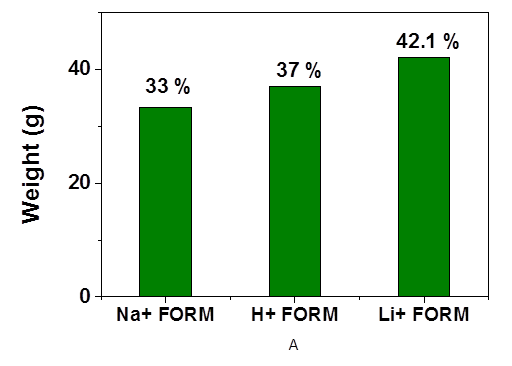
Recent Publications
[1] Su L, Darling R M, Gallager K G, Xie W, Thelen J L, Badel A F, Barton J L, Cheng K J, Balsara N P, Moore J S, Brushett F R (2016) An Investigation of the Ionic Conductivity and Species Crossover of Lithiated Nafion 117 in Nonaqueous Electrolytes. Journal of The Electrochemical Society 163(1): A5253-A5262
[2] Huang Q, Yang J, Ng C B, Jia C, Wang Q (2016) A redox flow lithium battery based on the redox targeting reactions between LiFePO4 and iodide. Energy & Environmental Science 9: 917-921
References
- Semiz L, Abdullayeva N, Sankir M (2018) Nanoporous Pt and Ru catalysts by chemical dealloying of Pt-Al and Ru-Al alloys for ultrafast hydrogen generation. Journal of Alloys and Compounds 744: 110-115.
- Serin R B, Abdullayeva N, Sankir M (2017) Dealloyed Ruthenium Film Catalysts for Hydrogen Generation from Chemical Hydrides. Materials 10(7): 738
- Abdullayeva N, Sankir M (2017) Influence of Electrical and Ionic Conductivities of Organic Electronic Ion Pump on Acetylcholine Exchange Performance. Materials 10(6): 586
- Akay T E, Abdullayeva N, Sankir M, Sankir N D (2016) On-Board Hydrogen Powered Proton Exchange Membrane Fuel Cells. ECS Transactions 75(14):511-513
- Sankir M, Semiz L, Sankir N D (2015) Catalyst free Hydrogen generation from directly disulfonated poly(arylene ether sulfone) copolymer Membranes. Journal of Membrane Science 496
Fatima Al Hameli
Khalifa University, UAE
Title: Fabrication of self-healing coating for withstanding desert based climate conditions

Biography:
Fatima Al Hameli has completed her graduation from Petroleum Institute, Abu Dhabi UAE with a Bachelor’s degree in Chemical Engineering in 2012. She has worked as a Senior Lab Technician for 3 years in the Microscopy Department of Borouge Ptv. Ltd. Innovation Center, which focused on developing new polymeric material for the market. Currently she is pursuing a Master’s degree in Khalifa University (Masdar Institute branch) in Materials Science and Engineering Department.
Abstract:
Solar energy is one of the most readily accessible sources of renewable energy that may be utilized in the United Arab Emirates. Yet at the same time the UAE has one of the most severe weather conditions as it has a harsh desert climate with high amounts of dust, and temperatures may reach up to 50 °C in the summer. Sand and tiny pebbles accumulate on solar panels forming small scratches on the coating surface resulting in reduction of its mechanical and optical properties, therefore reducing the potential maximum energy output. A proposed solution is the application of an epoxy coating with self-healing properties. Self-healing materials are commonly classified as either autonomic or non-autonomic materials. To benefit from both approaches this project will aim at utilizing both capsule based and intrinsic self-healing. The project also aims at utilizing the high temperatures of the UAE to act as the external stimulus to activate the intrinsic self-healing. The proposed self-healing coating is achieved by adding cellulose acetate butyrate (CAB) as the intrinsic healing agent and using halloysite nanotubes (HNT) to sequester healing agents as the capsule based approach. Various concentrations of CAB in epoxy are tested to obtain the best concentration for complete healing. Multiple healing temperature and time are also tested to obtain the optimum healing conditions. Samples were tested in outdoor conditions to study the effect of the weather and dust on the samples. Based on thermal and mechanical tests for complete healing of the material the optimum composition is an epoxy composite with 3 vol% CAB and 1 vol% HNT and the optimum healing temperature is 110 °C. Outdoor testing was carried out for three months during winter until the samples failed due to delamination. The addition of CAB provided improvement to the epoxy material to withstand weather conditions.
Image
Figure-1: Biweekly pictures of outdoor samples after washing and drying.
References
- D Y Wu, S Meure and D Solomon (2008) Self-healing polymeric materials: A review of recent developments. Progress in Polymer Science; 33: 479-522.
- S A Hayes, F R Jones, K Marshiya and W Zhang (2007) A self-healing thermosetting composite material. Composites Part A: Applied Science and Manufacturing; 38: 1116-1120.
- V Amendola and M Meneghetti (2009) Self-healing at the nanoscale. Nanoscale; 1: 74-88.
- B J Blaiszik, S L B Kramer, S C Olugebefola, J S Moore, N R Sottos and S R White (2010) Self-Healing Polymers and Composites. Annual Review of Materials Research; 40: 179-211.
- V K Thakur and M R Kessler (2015) Self-healing polymer nanocomposite materials: A review. Polymer; 69: 369-383.
Nujood Saeed Ali AlShehhi
Khalifa University, UAE
Title: Fabrication of antireflection and anti-soiling coatings for desert based solar panels

Biography:
Nujood Saeed Ali AlShehhi is currently pursuing her Master’s graduation in Khalifa University (Masdar Institute branch) and working on her Master’s degree in Materials Science and Engineering. Her research focus is on developing a polymer coating material with anti-reflective and anti-soiling properties as part of the project of a super coating.
Abstract:
This research paper focuses on the fabrication of antireflection and anti-soiling polymer composite by means of spray coating, which can be applied for solar panels. Due to the frequent sandstorms within the region dust accumulates on the panels reducing their efficiency in the absorption of solar radiation and because of scarcity of water sources in the Middle East in general the frequent cleaning consumes a lot of money and water. The objective is to fabricate and develop a coating for solar panels with anti-soiling and anti-reflection characteristics. The composite material chosen is the mineral material halloysite nanotube (HNTs). HNTs are chemically non-toxic and can be found in large amounts at low prices. The proposed method involves spray coating a polymer composite followed by plasma etching the surface to generate the necessary roughness. The first step is to etch the surface by exposing the samples to varying types of plasma with certain condition, varying time and concentration to obtain a rough surface and to make the etched surface suitable for the air refractive index. The second step is functionalization of the etched surface by CF4 plasma surface treatment. The Scanning Electron Microscope image shows how the different types of etching can affect the surface roughness, how HNTs are exposed to enhance the light transmission and to reduce/increase the wettability between the surface and the contact angle to achieve anti-reflection and self-cleaning properties. Optical and surface properties are further studied using spectroscopy and goniometer testing. From the results the optimum HNT concentration is 20 wt.% and the optimum etching conditions are etching with CF4 gas at 2 Pa and high power for 10 minutes. Finally, the spray coating can be developed with multi-characterization, long stability and low-cost coating that can easily be scaled up and applied onto current solar cells.
Peyman Akbari
Iran Polymer and Petrochemical Institute, Iran
Title: Synthesis of PEG-PLA diol as a new soft segment for biodegradable Urethane products
Biography:
Abstract:
Polyurethanes (PUs) are one of the vastly studied synthetic polymers in tissue engineering applications due to their diverse compositions and tunable physiochemical properties. A series of novel poly ethylene glycol/poly lactic acid (PEG-PLA) diols are synthesized. The success of synthesis and the structure of the block copolymers are demonstrated by FT-IR and H NMR analyses. The aim of this study is to develop a series of diols as soft segment for biodegradable urethane products. Making alteration to PEG:PLA ratio results in different degradation rates and mechanical properties of the urethane products. Briefly, PEG was reacted with lactic acid through a ring-opening polymerization using Sn(Oct)2 as catalyst at 180 ℃ under a N2 atmosphere to obtain a PLA-PEG-PLA block copolymer. The produced polymer was then precipitated successively in n-hexane/ethyl acetate solution. It shows the FT-IR spectra of PEG, PLA and PEG-PLA product. The characteristic absorption at 1753 cm-1 (C=O stretching) is observed, demonstrating the formation of ester linkage connecting PEG-PLA components. 1369 cm−1, 1456 cm−1 are respectively attributed to methyl and deformation vibration of C-H. The absorption peak at 2882 cm-1 indicates the presence of the alkyl C-H (stretching) bond in PEG spectra which agrees with the same peak in the PEG-PLA spectra. In conclusion, PEG-PLA block copolymers were prepared successfully. A series of PEG-PLA block copolymers were synthesized by ring opening polymerization of lactic acid and poly ethylene glycol. Copolymers were characterized by nuclear magnetic resonance (NMR) and infrared spectroscopy (IR), which confirmed that those were synthesized successfully. This synthetic diol can be used as soft segment for degradable polyurethane products in tissue engineering.
Image
References
- Ro A J, Huanga S J and Weiss R A (2009) Synthesis and Properties of Random Poly(Lactic Acid)-Based Ionomers. Polymer; 50: 1134-1143.
- Byuna Y, Rodriguezb K and Han J H (2015) Improved Thermal Stability of Polylactic Acid (PLA) Composite Film via PLA-β-Cyclodextrin-Inclusion Complex Systems. International Journal of Biological Macromolecules; 81: 591- 598.
- Diao J P, Wang H X, Chang N N, et al. (2015) PEG-PLA Nanoparticles Facilitate siRNA Knockdown in Adult Zebrafish Heart. Developmental Biology; 406: 196-202.
- Piorkowska E, Kulinski Z, Galeski A, et al. (2006) Plasticization of Semicrystalline Poly(L-Lactide) with Poly (Propylene Glycol). Polymer; 47: 7178-7188.
- Reddy M M, Vivekanandhana S and Misra M (2013) Biobased Plastics and Bionanocomposites: Current Status and Future Opportunities. Progress in Polymer Science; 38: 1653-1689.
Hadi Firoozi
Islamic Azad University, Iran
Title: Study of surface characteristics of biomaterials used for medical devices and biosensors

Biography:
Hadi Firoozi is a last year MSc student in Materials Science at Science and Research Branch at Islamic Azad University. His research experiences include surface characterization and modification materials as well as different methods of surface coating including chemical vapor deposition (CVD) and physical vapor deposition (PVD).
Abstract:
Introduction
The geometry, structural properties and importantly surface features of implants play an important role on their biocompatibility and post implantation induced foreign body response [1]. The formation of fibrotic tissue in the surrounding of implants can define their fate and potentially hinder the performance of medical devices by creating diffusional barriers for oxygen and nutrient transport [2-4]. The reduced transport dynamics can then lead to creation of hypoxic conditions affecting tissue function and performance of the implants [5,6]. It is therefore crucial to study the surface features and characteristics of biomaterials prior to implantation. In this study, porous pure titanium and stainless steel (304), two widely used prosthetics implants due to their proper elastic modulus, biocompatibility and corrosion resistant, and the ability to control their surface features are studied [7-11]. This investigation focuses on surface characteristics of these materials which are mostly used on outer surfaces of medical devices and as orthopedic implants.
Experimental procedure
Scanning electron microscopy (SEM) (performed by Quanta 600, FEI company) shows significant variability in the surface characteristic of all studied implant materials. The pore size and geometry is analyzed using MATLAB to map the pore distribution.
Results and discussion
The difference in pore size, pore shape and distribution of the studied stainless steel and pure titanium is shown in Figure 1. Their different porous structures can cause differences in induced foreign body response and ultimately the function of the medical devices and implants using them as outer surfaces.
Image:
A)

B)
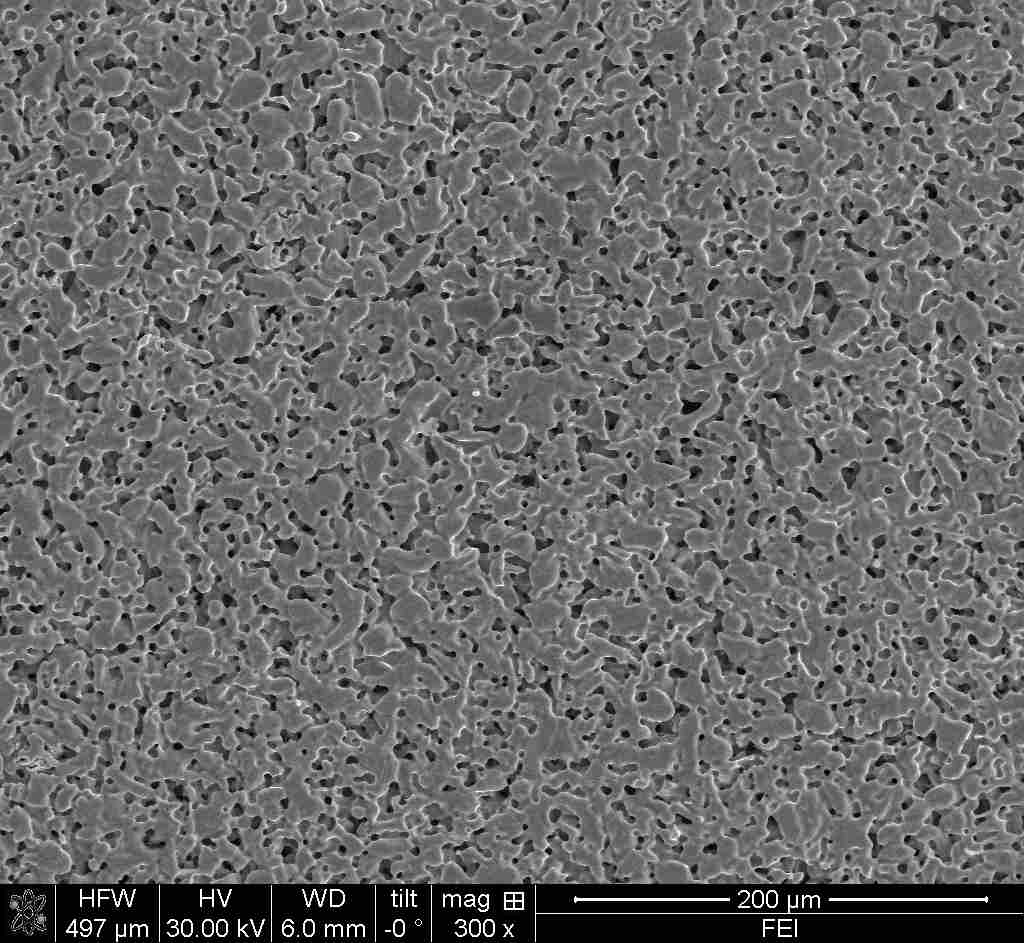
Fig. 1. Scanning electron microscopy (SEM) images of (A) porous stainless steel 314, (B) porous pure titanium.
Our image analysis shows a lower variety in pore size distribution and shape in stainless steel as compared to titanium. This might be because of higher ability to control the surface features for this material. These surface characteristics are important for medical devices because the induced fibrosis can change the diffusional characteristics, moreover the are crucially important for orthopedic implants as well, since the quality of the bone formed is greatly influenced by the properties of the implants. This investigation can be further extended to in vivo studies and histological analysis, results can then show how changes in pore size distribution affects the foreign body response.
Conclusion
Our analysis matched with an extensive literature study on foreign body response of different materials and their surface characteristics confirms the importance of our investigation on selection of biomaterials with appropriate surface features based on their final use in medical devices or implant applications. The stainless steel has shown a higher uniformity in pore size distribution. Following studies will discuss the effects of pore distribution on mechanical and diffusional characteristics of these materials.
References
- Anderson JM, Rodriguez A, Chang DT. Foreign body reaction to biomaterials. InSeminars in immunology 2008 Apr 1 (Vol. 20, No. 2, pp. 86-100). Academic Press.
- Tang L, Thevenot P, Hu W. Surface chemistry influences implant biocompatibility. Current topics in medicinal chemistry. 2008 Mar 1;8(4):270-80.
- Najdahmadi A, Lakey JR, Botvinick E. Diffusion coefficient of alginate microcapsules used in pancreatic islet transplantation, a method to cure type 1 diabetes. InNanoscale Imaging, Sensing, and Actuation for Biomedical Applications XV 2018 Feb 20 (Vol. 10506, p. 105061D). International Society for Optics and Photonics.
- Kummerfeld G, Krishnan R, Najdahmadi A, Botvinick E, Lakey JRT. Alginate composition and temperature influence microcapsule permeability. Royan international twin congress 11th congress on stem cell biology and technology. 2015/9;17(1):19–20.
- Higgins DM, Basaraba RJ, Hohnbaum AC, Lee EJ, Grainger DW, Gonzalez-Juarrero M. Localized immunosuppressive environment in the foreign body response to implanted biomaterials. The American journal of pathology. 2009 Jul 1;175(1):161-70.
- Najdahmadi A, Gurlin RE, Weidling J, White S, Shergill B, Lakey JR, Botvinick E. Non invasive study of oxygen tension and vascularization in subcutaneously implanted medical devices. InProc. SPIE 2018 (Vol. 10488, p. 1048847).
- Buser D, Broggini N, Wieland M, Schenk RK, Denzer AJ, Cochran DL, Hoffmann B, Lussi A, Steinemann SG. Enhanced bone apposition to a chemically modified SLA titanium surface. Journal of dental research. 2004 Jul;83(7):529-33.
- Schwarz F, Herten M, Sager M, Wieland M, Dard M, Becker J. Bone regeneration in dehiscenceâ€type defects at chemically modified (SLActive®) and conventional SLA titanium implants: a pilot study in dogs. Journal of clinical periodontology. 2007 Jan 1;34(1):78-86.
- Gotman I. Characteristics of metals used in implants. Journal of endourology. 1997 Dec;11(6):383-9.
- Najdahmadi A, Zarei-Hanzaki A, Farghadani E. Mechanical properties enhancement in Ti–29Nb–13Ta–4.6 Zr alloy via heat treatment with no detrimental effect on its biocompatibility. Materials & Design (1980-2015). 2014 Feb 1;54:786-91.
- Najdahmadi A, Zarei-Hanzaki A, Farghadani. Microstructural evaluation and mechanical properties of solution treated biomedical TNTZ alloy. International conference of metallurgical engineering society and foundry men’s society 1622-IMES-CONGR-FULL [Internet]. 2012 Oct; Available from: http://dx.doi.org/10.13140/RG.2.2.21846.96325
Takin Ghavimi
University of Tehran, Iran
Title: Fabrication of new LSCF infiltrated BSCF material to increase electrochemical performance of fuel cells

Biography:
Mr Takin Ghavimi graduated with his MSc in Materials Science from University of Tehran. His MSc research at university of Tehran focused on synthesis of novel electrode materials used in solid oxide fuels cell technology. Mr Ghavimi’s recent work aims to increase the performance and functionality of solid oxide fuel cells by development of advanced cathode materials.
Abstract:
Introduction
A solid oxide fuel cell (SOFC) is an electrochemical conversion device that produces electricity directly from fuels. These fuel cells are comprised of ceramic electrolytes that can provide high efficiency in performance, fuel flexibility and overall low cost of the system [1]. The main disadvantage of these systems is the high operation temperature, which can result in (1) formation of an insulating layer, caused by reaction between electrode and electrolyte materials, (2) the necessity of using high cost interconnecting materials such as LsCrO3 and (3) possibility of crack formation caused by thermal coefficient mismatch between the electrode and electrolyte materials [2]. As is shown in literature, material characteristics in general can be modified using different thermal and environmental treatments and before and after fabrication and synthesis [3-10]. In our work, we investigate modification methods to reduce the operating temperature of SOFCs without sacrificing the system performance through fabrication of a new solution infiltrated Ba0.5Sr0.5Co0.8Fe0.2O3-δ (BSCF) cathode, employing the two most effective cathode materials BSCF (Ba0.5Sr0.5Co0.8Fe0.2O3-δ) and LSCF (La0.6Sr0.4Co0.2Fe0.8O3-δ).
Methods and materials
Ceramics were synthesized using co-precipitation method at precipitation pH of at least 8 and a calcination temperature of 1000°C. The structure of synthesized ceramics is studied using X-ray diffraction (Philips PW-1730).
Results and discussion
BSCF has the advantage of high ionic conductivity due to its high concentration of oxygen vacancies, enabling it to easily permit the diffusion of oxygen ions while LSCF is known to possess significantly higher electronic conductivity as well as better performance at operating temperatures of bellow 750 ºC [11,12]. We aim to achieve both characteristics of the individual components. To produce the infiltrated BSCF, we first used our developed method of co-precipitation synthesis, which was followed by structure analysis using X-ray Diffraction (XRD). The synthesized powders were then used to fabricate electrochemical half cells. These cells were infiltrated with a nitrate solution of LSCF and calcined at 1000 ºC for 5 hours to permit the LSCF to crystalize. The electrochemical performance of the half cells was then evaluated. Our results show the cells with infiltrated BSCF electrode possess higher electronic conductivity than those with pure BSCF electrodes.
Image:
A)

B)

Fig.1. Impedcance spectra of (A) BSCF infiltrated LSCF and (B) LSCF at 600 ºC shows lower resistance and therofore higher electonic conductivity in BSCF/LSCF
Conclusion
The results of this investigation can be used in fabrication of fuel cells capable of operating in lower temperatures, which can reduce the overall costs of obtaining electricity and increase the performance efficiency.
References:
- Fergus J, Hui R, Li X, Wilkinson DP, Zhang J. Solid Oxide Fuel Cells: Materials Properties and Performance. CRC Press; 2008. 298 p.
- Singhal SC, Kendall K. High-temperature Solid Oxide Fuel Cells: Fundamentals, Design and Applications. Elsevier; 2003. 406 p.
- Chang J-K, Chen Y-L, Tsai W-T. Effect of heat treatment on material characteristics and pseudo-capacitive properties of manganese oxide prepared by anodic deposition. J Power Sources. 2004;135(1-2):344–53.
4. Najdahmadi A, Zarei-Hanzaki A, Farghadani E. Mechanical properties enhancement in Ti–29Nb–13Ta–4.6Zr alloy via heat treatment with no detrimental effect on its biocompatibility. Mater Des. 2014;54:786–91.
5.Kokubo T, Miyaji F, Kim H-M, Nakamura T. Spontaneous Formation of Bonelike Apatite Layer on Chemically Treated Titanium Metals. J Am Ceram Soc. 1996;79(4):1127–9.
6.Najdahmadi A, Zarei-Hanzaki A, Farghadani. Microstructural evaluation and mechanical properties of solution treated biomedical TNTZ alloy. International conference of metallurgical engineering society and foundry men’s society 1622-IMES-CONGR-FULL [Internet]. 2012 Oct; Available from: http://dx.doi.org/10.13140/RG.2.2.21846.96325
7. KochmaÅ„ska A, Garbiak M. High-Temperature Diffusion Barrier for Ni-Cr Cast Steel. Diffus Defect Data Pt A. 2011;312-315:595–600.
8. Najdahmadi A, Lakey JR, Botvinick E. Diffusion coefficient of alginate microcapsules used in pancreatic islet transplantation, a method to cure type 1 diabetes. InNanoscale Imaging, Sensing, and Actuation for Biomedical Applications XV 2018 Feb 20 (Vol. 10506, p. 105061D). International Society for Optics and Photonics
9. Wei C, Srivastava D, Cho K. Thermal Expansion and Diffusion Coefficients of Carbon Nanotube-Polymer Composites. Nano Lett. 2002;2(6):647–50.
10. Kummerfeld G, Krishnan R, Najdahmadi A, Botvinick E, Lakey JRT. Alginate composition and temperature influence microcapsule permeability. Royan international twin congress 11th congress on stem cell biology and technology. 2015/9;17(1):19–20.
11.Li S, Zhe L, Huang X, Wei B, Su W. Thermal, electrical, and electrochemical properties of Lanthanum-doped Ba0.5Sr0.5 Co0.8Fe0.2O3–δ. J Phys Chem Solids. 2007;68(9):1707–12.
12. Tsipis EV, Kharton VV. Electrode materials and reaction mechanisms in solid oxide fuel cells: a brief review. J Solid State Electrochem. 2008;12(11):1367–91.
Takin Ghavimi
University of Tehran, Iran
Title: Synthesis and stabilization of highly conductive cubic SrCoO3 to increase solid oxide fuel cell efficiency

Biography:
Mr Takin Ghavimi graduated with his MSc in Materials Science from University of Tehran. His MSc research at university of Tehran focused on synthesis of novel electrode materials used in solid oxide fuels cell technology. Mr Ghavimi’s recent work aims to increase the performance and functionality of solid oxide fuel cells by development of advanced cathode materials.
Abstract:
Introduction: SrCoO3 is an important perovskite parent compound used for development of a variety of functional materials. As is shown in literature structural properties of different materials can change in different environments, operation temperatures and oxygen partial pressures [1-8]. Additionally, in ceramics such as SrCoO3 thermal history and synthesis process can be important factors in displaying multiple crystal structures [9]. Replacement of 20% of cobalt with iron is shown to improve the electric conductivity of this material SrCoO3 [10]. The perovskite SrCo0.8Fe0.2O3 can display mixed ionic and electronic conducting properties (MIEC) which makes this oxide useful for a variety of applications, including fabrication of oxygen separation membranes, combustion catalysts and importantly cathode/anode materials for solid oxide fuel cells (SOFC), a device that can produce electricity directly from fuels such as hydrogen and methane[11,12]. Important to our research is the cubic structure of this material which possesses the highest electronic and oxygen ionic conductivity with a reported total electric conductivity of 160 S.cm-1 at 950°C [13]. It is shown that substitution of various elements in the A and B site of this material can increase the stability of its cubic crystal structure. In this study, we have adopted a strategy of element substitution in the A site of the SrCo0.8Fe0.2O3 perovskite to stabilize its cubic crystal structure, which is believed to result in an improvement of the electric conductivity of this material.
Methods and materials: Ceramics were synthesized using co-precipitation method. the precipitation pH of at least 8 is required for the precipitation to be completed. The precipitates are subsequently calcined at a temperature of 1000°C to achieve the perovskite. The structure of synthesized ceramics is then studied using X-ray diffraction (Philips PW-1730) and scanning electron microscopy (TESCAN-MIRA3)
Results and Discussion: SrCo0.8Fe0.2O3 (SCF) and A site barium doped SCF were synthesized by a novel co-precipitation method to examine the effect of barium substitution on stabilization of the SCF cubic lattice. After synthesis, the obtained crystal structures were analyzed to evaluate the success of our co-precipitation method. Our results show that by replacement of 50% strontium with barium, the hexagonal structure of SCF at room temperature was changed to cubic (Fig. 1A & Fig.1B). Modification of the temperature and environment of synthesis further increased the success in achieving a pure cubic perovskite phase . Figure 2 shows and SEM image of the cubical perovskite structure.
Image:
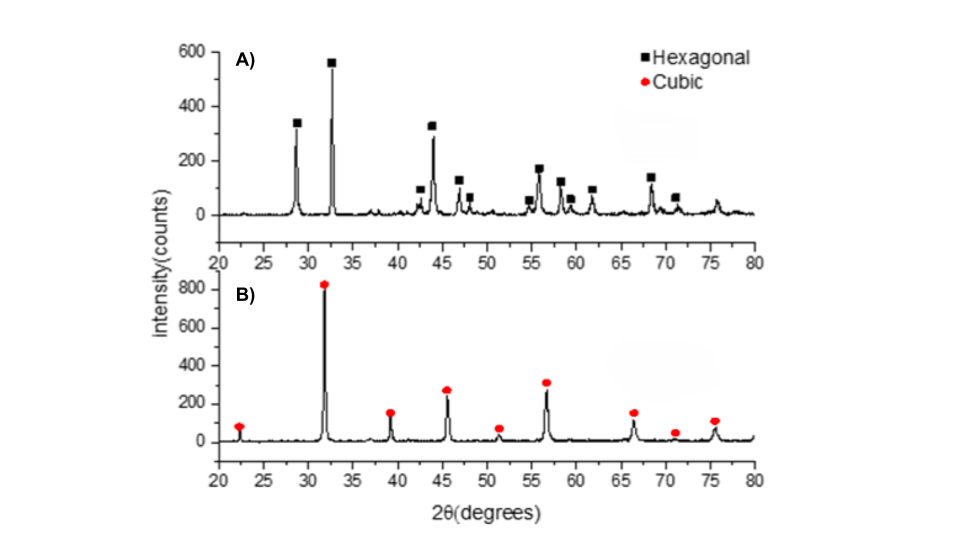
Fig. 1. XRD image of (1.A) hexagonal SrCo0.8Fe0.2O3 and cubical Ba doped SrCo0.8Fe0.2O3

Fig. 2. Scanning electron microscopy of cubical Ba doped SrCo0.8Fe0.2O3.
Conclusion: Our strategy can result in a more stable cubic structure of SCF perovskite oxide. This new perovskite with the chemical formula Ba0.5SrCo0.8Fe0.2O3 can be used in fabrication of device compartments with higher electronic and oxygen ionic conductivity such as new class of cathodes for SOFCs. These new fuel cell devices can potentially increase the efficiency and performance of solid oxide fuel cells and eventually result in significantly lower costs the production electricity.
References:
- Chang J-K, Chen Y-L, Tsai W-T. Effect of heat treatment on material characteristics and pseudo-capacitive properties of manganese oxide prepared by anodic deposition. J Power Sources. 2004;135(1-2):344–53.
2. Najdahmadi A, Zarei-Hanzaki A, Farghadani E. Mechanical properties enhancement in Ti–29Nb–13Ta–4.6Zr alloy via heat treatment with no detrimental effect on its biocompatibility. Mater Des. 2014;54:786–91.
3. Kokubo T, Miyaji F, Kim H-M, Nakamura T. Spontaneous Formation of Bonelike Apatite Layer on Chemically Treated Titanium Metals. J Am Ceram Soc. 1996;79(4):1127–9.
4. Najdahmadi A, Zarei-Hanzaki A, Farghadani. Microstructural evaluation and mechanical properties of solution treated biomedical TNTZ alloy. International conference of metallurgical engineering society and foundry men’s society 1622-IMES-CONGR-FULL [Internet]. 2012 Oct; Available from: http://dx.doi.org/10.13140/RG.2.2.21846.96325
5. KochmaÅ„ska A, Garbiak M. High-Temperature Diffusion Barrier for Ni-Cr Cast Steel. Diffus Defect Data Pt A. 2011;312-315:595–600.
6. Najdahmadi A, Lakey JR, Botvinick E. Diffusion coefficient of alginate microcapsules used in pancreatic islet transplantation, a method to cure type 1 diabetes. InNanoscale Imaging, Sensing, and Actuation for Biomedical Applications XV 2018 Feb 20 (Vol. 10506, p. 105061D). International Society for Optics and Photonics
7. Wei C, Srivastava D, Cho K. Thermal Expansion and Diffusion Coefficients of Carbon Nanotube-Polymer Composites. Nano Lett. 2002;2(6):647–50.
8. Kummerfeld G, Krishnan R, Najdahmadi A, Botvinick E, Lakey JRT. Alginate composition and temperature influence microcapsule permeability. Royan international twin congress 11th congress on stem cell biology and technology. 2015/9;17(1):19–20.
9. Ito Y, Klie RF, Browning ND, Mazanec TJ. Atomic Resolution Analysis of the Defect Chemistry and Microdomain Structure of Brownmilleriteâ€Type Strontium Cobaltite. Journal of the American Ceramic Society. 2002 Apr 1;85(4):969-76
10. Teraoka Y, Nobunaga T, Okamoto K, Miura N, Yamazoe N. Influence of constituent metal cations in substituted LaCoO3 on mixed conductivity and oxygen permeability. Solid State Ionics. 1991 Nov 1;48(3-4):207-12.
11. Fergus J, Hui R, Li X, Wilkinson DP, Zhang J, editors. Solid oxide fuel cells: materials properties and performance. CRC press; 2016 Apr 19.
12. Qiu L, Lee TH, Liu LM, Yang YL, Jacobson AJ. Oxygen permeation studies of SrCo0. 8Fe0. 2O3− δ. Solid State Ionics. 1995 Mar 1;76(3-4):321-9.
13. Deng ZQ, Yang WS, Liu W, Chen CS. Relationship between transport properties and phase transformations in mixed-conducting oxides. Journal of Solid State Chemistry. 2006 Feb 1;179(2):362-9


